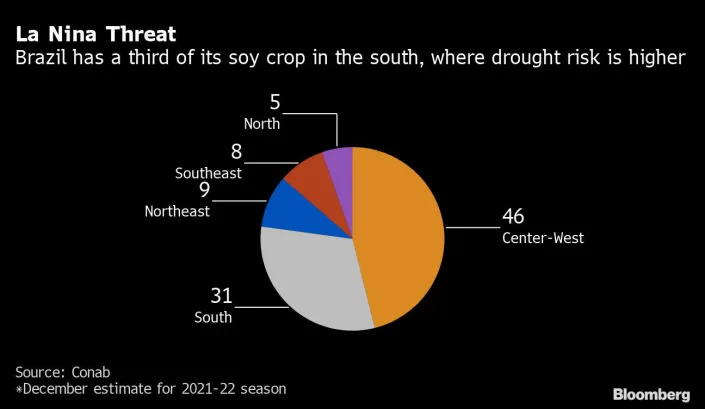

Tatiana Freitas
Wed, December 22, 2021
(Bloomberg) -- The impact of the La Nina weather pattern that’s expected to roil global food markets in coming months is already showing up in parts of Brazil, the world’s biggest soybean exporter.
In 20 years as a soybean farmer, Adriano Marco Vivian has never seen his fields so dry, with leaves burnt by excessive heat and lack of rain. La Nina can mean drought in many growing areas, including southern Brazil.
“I believe around 70% of the yield potential has been lost,” Vivian, who is based in Parana, one of the top-producing states in the nation’s south, said in a telephone interview. “We haven’t seen widespread rains for more than 60 days,” said the farmer, who planted 700 hectares of soybeans in the state’s west. The picture is similar for all producers in the region, he said.
Parched conditions and heat led Parana’s agriculture agency Deral to cut its estimate for output in the state by 12% on Wednesday, and more may be coming if adverse weather continues, said Marcelo Garrido, an economist at Deral. The prospect of a second straight La Nina trimming what’s otherwise expected to be a bountiful harvest is helping boost soybean prices and adding to worries over global food inflation.
Some local consultancies have already lowered Brazil’s soybean output estimate due to yield losses in the south. That’s the case for Parana-based AgRural, which reduced its production estimate by to 144.7 million tons from 145.4 million in the previous forecast.
For now, farmers in Parana are an exception in Brazil, where beneficial weather has allowed a good crop development in central and northern areas.
“Brazil is still expected to harvest a record crop,” Daniele Siqueira, an analyst at AgRural, said by telephone. “Parana is the only region with consolidated losses so far.”
All eyes will remain on Brazil’s south. Rio Grande do Sul, a top-growing state at the border with Argentina, reported below-average rain during seeding, which is now almost finished. Some farms needed replanting, but yields won’t be known until next year. If good rains fell from now on, the state can still reap a good crop.
While some isolated and weak precipitation may be seen in the south in the coming days, it won’t be enough to restore soil-moisture in time to allow soybeans to recover in Parana, according to Celso Oliveira, a meteorologist at Climatempo in Sao Paulo. Rain should be in line with historical averages starting in the second half of January, benefiting crops in Rio Grande do Sul. But it will be too late for Parana’s, including Vivian’s crop.
No comments:
Post a Comment